|

by Cheyenne Macdonald
01 June 2016
from
Dailymail Website
Equivalent Spanish version
Now robots can have KIDS:
Researchers create machines that 'mate'
over Wi-Fi
to create a 3D printed baby
and experts say they could be used to
colonize Mars.
The 'Robot Baby Project' mimics sexual reproduction to let robots
'evolve'.
Parent robots can send their genomes through the Wi-Fi network to
mate.
A mechanism creates genome for offspring, randomly combining
features.
Eventually, they say, robots will 'develop their bodies through
evolution'.
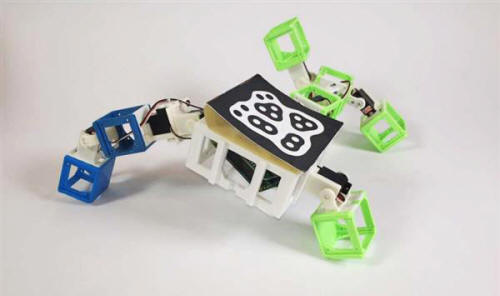
These
Technocrat scientists believe that the
'Evolution of Things' will take off and produce
a new race of robots that will spontaneously
create new iterations of offspring, supposedly
better than there parents.
Some hope
to use the technology to colonize Mars.
Source
What if robots could evolve?
It's the question asked by a group of scientists in Amsterdam, whose
radical new project aims to create smarter, more advanced robots
through a process similar to sexual reproduction.
While the idea may sound far-fetched, they've already demonstrated a
proof of concept - in February, two robot parents came together to
'mate,' and the first 'robot baby' was born.
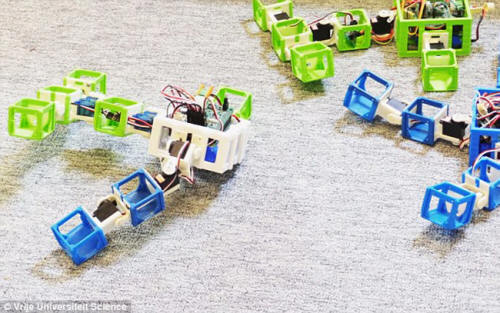
What if robots could
evolve?
It's the question asked
by a group of scientists in Amsterdam, whose radical
new project aims to create smarter, more advanced
robots through a process similar to sexual
reproduction.
On the right, the two
parent robots can be seen near their 'baby,' which
is pictured left
In the Robot Baby Project at
Vrije Universiteit Amsterdam,
scientists have developed a way for robots to have 'sex' and pass on
their DNA to offspring.
Doing this can allow them to 'develop their bodies through
evolution,' making for successive generations that have more
advanced physical and behavioral capabilities.
As the process continues, the researchers say robots can become more
suitable for use in unknown environments that could be hazardous to
humans, like deep sea mines or even other planets.
'We have two robots that meet and
mate, and just as in the animal kingdom, this results in a
baby,' says Guszti Eiben, Professor of Artificial Intelligence
at VU, in a video explaining the concept.
The robots live, work, and reproduce in
an 'Arena,' where they are able to select a suitable mating partner.
They learn through motivation, the researchers explain, and in this
case, they are motivated to walk toward a red light.
When the two robots come together, they are then able to communicate
and even mate.
HOW ROBOTS 'REPRODUCE'
Robots are put into an arena where they live, work, and
reproduce.
The researchers motivate them to move toward a red light, where
they can communicate and even mate.
Once they've evaluated each other and decide to reproduce, the
robots send their genomes through the Wi-Fi network.
A sexual reproduction mechanism then creates the genome for the
offspring, randomly combining the features from the parents,
including software (the brain) and hardware.
The code is then sent to a 3D printer to create the new parts.
Through this process, the researchers say robots can
autonomously 'develop their bodies through evolution,' making
for successive generations that have more advanced physical and
behavioral capabilities.
'When they evaluate each other
favorably, they send their genomes through the Wi-Fi network,'
says Milan Jelisavcic, a PhD student at the university.
'A sexual reproduction mechanism then creates the new genome.
Code of this genome is sent to the 3D printer then, for printing
new components.'
During a year-and-a-half development
period, the researchers were able to achieve the implementation of a
full life cycle.
When the parent robots 'reproduce,' their features are randomly
recombined.
This includes the brain - software - and the hardware.
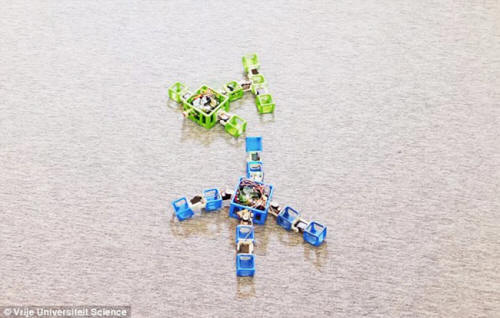
Scientists have
developed a way for robots to have 'sex' and pass on
their DNA to offspring.
Doing this can allow
them to 'develop their bodies through evolution,'
making for successive generations that have more
advanced physical and behavioral capabilities.
Parent robots are
pictured above
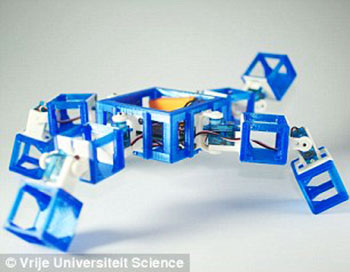 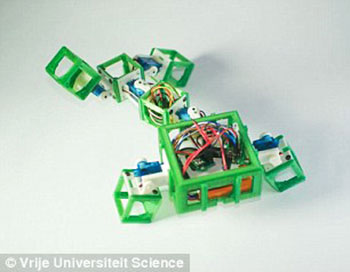
The researchers motivate
them to move toward a red light, where they can
communicate and even mate.
Once they've evaluated
each other and decide to reproduce, the robots send
their genomes through the Wi-Fi network.
'With evolutionary techniques, we
evolve the neural networks of the robots,' explains Jacqueline
Heinerman, PhD student at VU, in the video.
These neural networks are responsible
for their behaviors.
The lab also contains a 'Birth Clinic' and a 'Nursery' for the
robotic child, and once born, each must undergo a learning process.
If it is deemed satisfactory, the child then becomes an adult, and
potentially, a parent.
Researchers say this marks the start of a new era - the Industrial
Evolution.
In this state, machines could autonomously operate and reproduce.
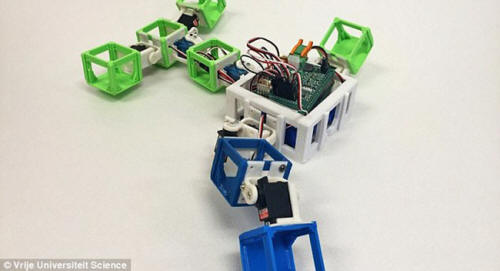
A sexual reproduction
mechanism then creates the genome for the offspring,
randomly combining the features from the parents,
including software (the brain) and hardware.
This can be seen in the
'robot baby' above, which has both blue and green
parts
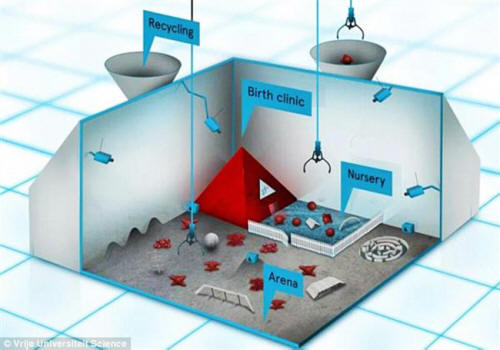
The robots live, work,
and reproduce in an 'Arena,' where they are able to
select a suitable mating partner.
The lab also contains a
'Birth Clinic' and a 'Nursery' for the robotic
child, and once born, each must undergo a learning
process.
If it is deemed
satisfactory, the child then becomes an adult, and
potentially, a parent
'Evolution is a great designer,'
says Eiben.
'The Evolution of Things is an emerging new technology that
exploits the power of selection and reproduction to breed robot
designs that are hard to obtain by traditional approaches.
Robots that evolve can adapt to their environment and cope with
unforeseen situations.
'The bodies, brains, and behaviors are continually tested by the
environment and the useful traits are amplified in future
generations. This technology opens new perspectives for
robotics, artificial intelligence, space research, and even
biology.'
The researchers unveiled the first robot
baby on May 26 at Campus Party in the Jaarbeurs in Utrecht,
demonstrating their novel method of 'robot mating.'
One day, they say, this new form of evolution could even play a
critical role in the colonization of Mars.
'What does it all mean? It means a
proof of concept,' Eiben explains in the video.
'And the concept we prove is the evolution of robots and
physical hardware. For science this means that artificial
evolution can break out of computer simulations and enter the
real world.'
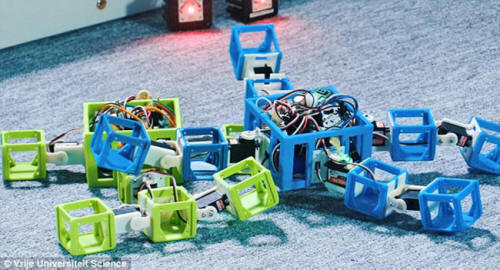
While the idea may sound
far-fetched, they've already demonstrated a proof of
concept - in February, two robot parents came
together to 'mate,' and the first 'robot baby' was
born.
Robot parent can be seen
interacting in the photo above
|









